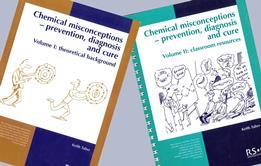Many students find it difficult to write word equations, which require an appreciation of the nature of chemical change
These materials provide probes for exploring whether students can complete word equations, and a set of practice exercises.
Completing word equations
Word equations are used to describe chemical reactions. Look at the word equations below. In each case, complete the word equation by adding the name of the missing substance, and explain your answers.
- Nitric acid + potassium hydroxide →___________________ + water
- Zinc + _______________________ →zinc nitrate + copper
- ___________________+ zinc carbonate →zinc sulfate + water + carbon dioxide
- Calcium + chlorine →____________________
- magnesium + hydrochloric acid →______________________ + hydrogen
Answers
Teachers will have their own ideas about what is an acceptable explanation for students’ completions, depending upon the age of the students and the depth to which ideas about reactions have been studied. Suggested explanations are provided
- Nitric acid + potassium hydroxide → potassium nitrate + water
- In this type of reaction a salt is formed from an acid and an alkali.
- The reactants include elements which must also be present in the products.
- As the reacting alkali is potassium hydroxide, then the product will be a potassium salt. As the reacting acid is nitric acid, then the salt produced will be a nitrate.
- Zinc + copper nitrate → zinc nitrate + copper
- In this type of reaction a more reactive metal displaces a less reactive metal from its salt.
- The reactants include elements which must also be present in the products.
- As the displaced metal is copper, then the reacting salt must have been a copper salt. As the product was a nitrate, then the reacting salt will also be a nitrate.
- Sulfuric acid + zinc carbonate → zinc sulfate + water + carbon dioxideC
- In this type of reaction an acid reacts with a carbonate to give a salt, water and carbon dioxide.
- The reactants include elements which must also be present in the products.
- As the product is a sulfate then the reacting acid must be sulfuric acid.
- Calcium + chlorine → calcium chloride
- In this type of reaction a binary compound is prepared from two elements.
- The reactants include elements which must also be present in the products.
- Magnesium + hydrochloric acid → magnesium chloride
- In this type of reaction an acid reacts with a metal to produce a salt and hydrogen.
- The reactants include elements which must also be present in the products.
- As the reacting acid is hydrochloric acid, then the salt produced will be a chloride. As the reacting metal is magnesium, then the product must be a magnesium salt.
This resource can be used as part of an entire lesson plan for 14–16 year olds on writing word equations.
Word equations information
Word equations are a shorthand used to describe chemical reactions.
Although there are many millions of possible chemical reactions you are not expected to know about them all. It is useful to remember that many reactions are of similar types.
Metal and acid
One type of reaction is that between a metal and an acid.
When a metal reacts with an acid the reaction produces a salt, and hydrogen gas is released. The salt produced depends upon the metal and the acid.
If magnesium reacts with hydrochloric acid, then the salt produced is magnesium chloride.
Metal + acid → salt + hydrogen
Metal carbonate + acid
Metal carbonates also react with acid, to give a salt. When a carbonate reacts with acid the gas carbon dioxide is given off.
The salt produced depends upon which acid, and which metal carbonate react.
If zinc carbonate reacts with sulfuric acid, then the salt produced is zinc sulfate.
Metal carbonate + acid →salt + carbon dioxide + water
Acid + alkali
When an alkali and an acid react the product is a salt solution.
The particular salt produced depends upon which acid and which alkali reacted.
When nitric acid reacts with potassium hydroxide the salt produced is potassium nitrate.
Acid + alkali → salt + water
Metal + salt solution
When a reactive metal is placed in the solution of a salt of a less reactive metal, a ‘displacement’ reaction occurs.
The more reactive metal is said to displace the less reactive metal from solution.
For example zinc is added to copper nitrate solution the copper is displaced and the solution will contain zinc nitrate.
Element + element
When two elements react together to form a compound the compound is given a name to show which elements reacted.
So if calcium reacts with chlorine the compound is called calcium chloride.
These examples show you the patterns that are found in five important types of reaction. If you look for patterns you should find it easier to work out how to complete word equations.
In this worksheet you will find some examples to help you practice thinking about word equations.
Notes
The information above is an extract of the chapter on word equations. For the full version of this chapter, see downloads below.
Downloads
Word equations
PDF, Size 0.46 mb
Websites
Additional information
These resources have been taken from the book, Chemical Misconceptions : Prevention, diagnosis and care: Theoretical background, Volume 2, by Keith Taber.

Chemical misconceptions

Discover classroom strategies and activities to tackle common misconceptions among students in chemistry, and explore the theory behind different approaches.
- 1
- 2
- 3
- 4
- 5
- 6
- 7
- 8
- 9
- 10
- 11
- 12
- 13
- 14
- 15
- 16
 Currently
reading
Currently
reading
Word equations
- 18
- 19
- 20
- 21
- 22
- 23
- 24
- 25
- 26
- 27
- 28
- 29
- 30
- 31
- 32
- 33
- 34
- 35
- 36





























































































No comments yet